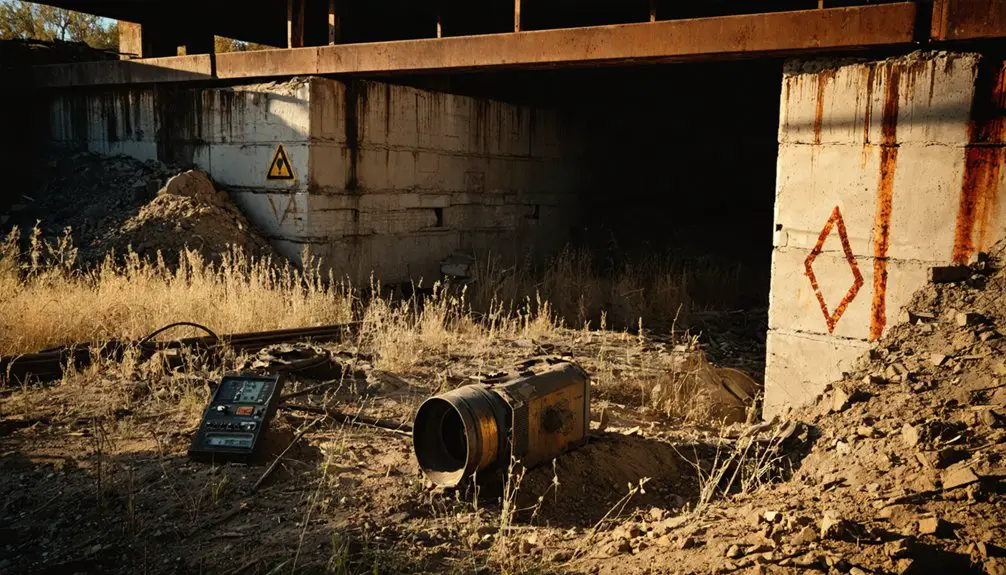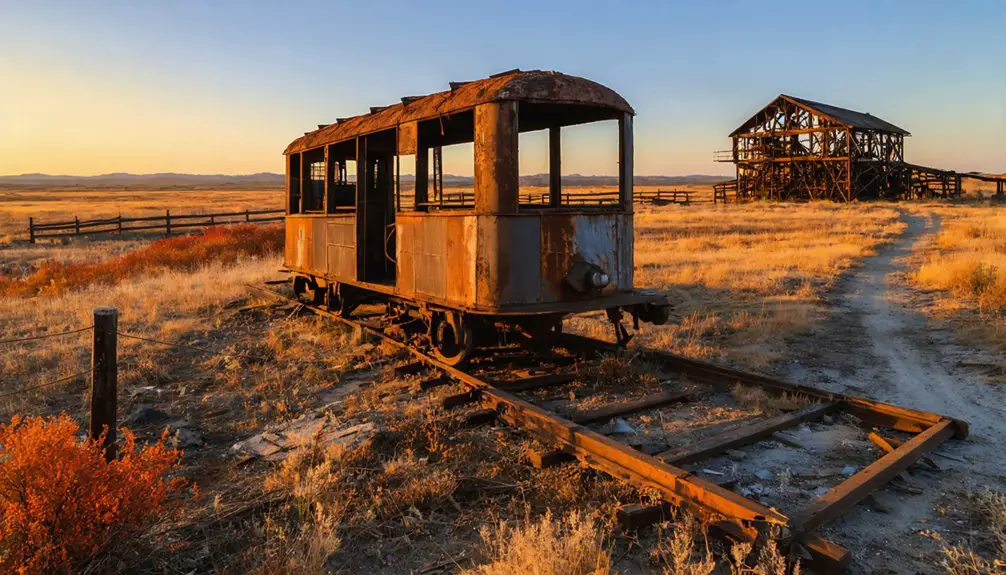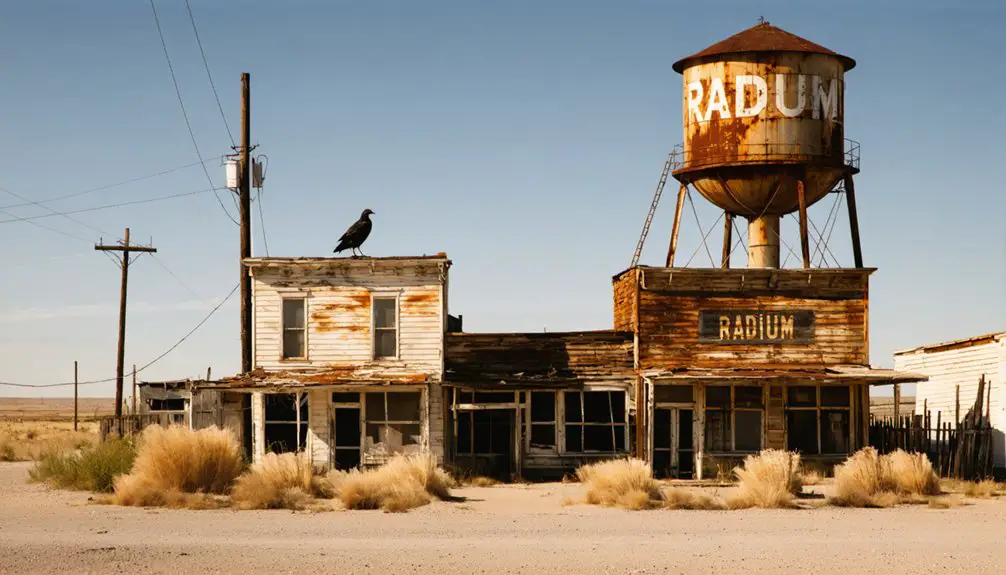You won’t find Radium Town as a ghost town – it’s actually present-day Claremore, Oklahoma. In 1903, drillers accidentally struck mineral-rich artesian waters instead of oil, transforming this small farming community into a booming health tourism destination. The town’s sulfuric “radium waters” drew thousands seeking cures in elaborate bathhouses and hotels like the Will Rogers Hotel. While the health tourism boom ended, Claremore’s historic buildings still stand as a tribute to its unique mineral water heritage.
Key Takeaways
- Claremore, Oklahoma, known as “Radium Town,” transitioned from a bustling health tourism destination to economic decline during the Great Depression.
- The town’s mineral water bathhouses and hotels, once serving 500 clients daily, now stand repurposed or abandoned.
- Medical science’s debunking of radium water’s therapeutic benefits led to the town’s decreased popularity as a health destination.
- Construction of Will Rogers Freeway bypassed the town center, contributing to deteriorating infrastructure and reduced visitor traffic.
- Original bathhouses and hotels remain as historical structures, with some converted to modern businesses while others stand vacant.
The Discovery of ‘Radium Water’ in Claremore
While drilling for oil and gas in 1903, the Claremore Industrial Company inadvertently struck a remarkable mineral water source that would transform the Oklahoma town’s destiny.
Through their contractors Gullinger & Hessicks, they discovered an artesian well that forcefully shot sparkling water from 1,800 feet below ground.
Though initially attributed to George W. Eaton, who later analyzed its mineral properties, the discovery actually belonged to the company. The water burst four to five feet above the surface before flowing into a nearby creek.
While Eaton studied the water’s properties, credit for discovering Claremore’s famous mineral spring rightfully belongs to the Industrial Company.
The town quickly established seven bathhouses to accommodate the growing number of visitors seeking therapeutic treatments.
You’ll find it interesting that despite its name, the water contained no actual radium – a common health misconception of the era.
Instead, the distinctive sulfurous odor came from hydrogen sulfide compounds. The cool, clear water bubbled naturally to the surface without pumping, and while it lacked radioactive elements, its rich mineral content would soon attract thousands seeking its purported healing powers.
Rise of a Health Tourism Destination
As news of Claremore’s mineral-rich waters spread in the early 1920s, the town transformed into a bustling health tourism destination that would define its economic growth.
You’d find visitors flocking to experience the purported health benefits of radium water treatments, with bathhouses and hotels serving up to 80 patrons daily. The town’s motto, “Where the World Comes to Get Well,” perfectly captured its newfound identity. The hotel’s signature Radium Bath House offered visitors a unique top-floor bathing experience. The annual Bath Week celebrations drew crowds with parades and promotional events.
- Will Rogers’ celebrity endorsement catapulted the town’s reputation nationwide
- Affordable treatments ($1.50 for baths, $1.25 for massages) made wellness accessible
- Roman-inspired bathhouses offered modern amenities and trained attendants
- Marketing emphasized natural healing over “artificial” medical treatments
The economic impact rippled through the community as restaurants, retail shops, and hospitality services flourished, creating jobs and fostering urban development.
Notable Bath Houses and Hotels
Once radium water treatments gained popularity, Claremore’s bath houses and hotels emerged as architectural landmarks that defined the town’s therapeutic landscape.
You’d find distinctive bath house architecture across the town, from the pioneering Claremore Radium Wells Company Bath House, built in 1904 for $75,000, to the luxurious Will Rogers Hotel‘s dedicated treatment floor. Dr. W.M. Lee served as the attending physician at Cobb’s establishment. The Will Rogers Hotel offered mineral bath services that featured water containing 13 different minerals.
The healing traditions extended to serve all communities, with Emanuel Cobb’s establishment becoming the largest African American bath house in Rogers County, while Pratt’s Bath House offered specialized treatments on Missouri Avenue.
Each facility showcased unique features – the Bungalow Hotel sold branded radium water jars, while the Hotel Sequoyah incorporated adjacent bath facilities.
These establishments clustered in Radium Town, where the sulfurous mineral waters promised cures through various therapeutic combinations of baths, steam treatments, and massages.
Will Rogers’ Influence on Local Fame
The bustling bath houses and hotels of Radium Town gained national recognition through the influential voice of Will Rogers, Oklahoma’s beloved native son. Through his radio broadcasts and newspaper columns, Rogers’ endorsements transformed this small Oklahoma town into a sought-after destination. The discovery of artesian mineral water in 1903 established Claremore as a premier health destination. The historic Hotel Will Rogers remains a testament to this era, having undergone a $2.4 million renovation to preserve its legacy.
His humorous commentary about the radium waters’ healing properties, combined with civic pride initiatives like “Take a Bath Week,” created a unique cultural identity that distinguished Claremore from other mineral spring resorts.
Radium waters and witty local pride campaigns transformed Claremore into more than just another health spa destination.
- The Hotel Will Rogers, opened in 1930, became a prestigious destination due to its namesake’s fame.
- Rogers’ jokes about radium water “curing everything but being a Democrat” added charm to marketing efforts.
- Local civic groups leveraged his celebrity status through parades and promotional events.
- His family’s deep roots in the region, including Rogers County being named after his father, strengthened the area’s cultural significance.
Daily Life and Business Operations
During your visit to Radium Town’s bath houses, you’d start your day with a therapeutic soak in sulfuric waters falsely marketed as radium-infused, followed by treatments that claimed to cure ailments from rheumatism to dandruff.
You could find lodging at establishments like the two-story Bungalow Hotel at 119 S. Cherokee Street or Hotel Sequoyah at Missouri Avenue and Third Street, both equipped with their own bath facilities. Both hotels offered promotional ceramic vessels, with the Bungalow featuring a 4.5-inch ceramic jar sold in its gift shop.
The bath house district thrived through a network of supporting businesses, including a grocery store, cafe, laundry service, and pharmacy, creating a self-contained health resort ecosystem that served thousands of visitors during the early 1900s.
Despite the popularity of treatments, practicing medicine without license charges plagued facility operators like W.J. Perdue who faced ongoing legal troubles.
Bath House Daily Routines
Bath houses in Radium Town operated as sophisticated health facilities, serving up to 500 clients daily with standardized pricing of $1.50 for baths and $1.25 for massages in the early 20th century.
The bath house therapies followed a precise sequence, with attendants guiding you through mineral-rich radium water soaks, steam treatments, and Swedish massage sessions. Staff responsibilities included managing the 65-horsepower boilers, monitoring treatment rooms, and maintaining pristine facilities.
- You’d start with a therapeutic radium water bath in glass tubs
- Steam cabinet sessions would follow to enhance detoxification
- Swedish massage completed your treatment routine
- You’d finish in cooling rooms designed for temperature regulation
These well-orchestrated routines made Radium Town’s bath houses renowned for their systematic approach to health treatments.
Visitor Lodging and Meals
While seeking radium water cures in the early 1900s, visitors to Radium Town could choose from several sophisticated lodging options, including the flagship Hotel Will Rogers – a six-story concrete-and-steel structure featuring 78 rooms and Spanish décor.
You’d find accommodations ranging from one-day stays to two-week wellness retreats at venues like the two-story Bungalow Hotel or Hotel Sequoyah, each with attached bath houses.
Your visitor experience would include professional services from bellhops and maids, while culinary offerings centered around the Hotel Will Rogers’ renowned coffee shop.
Whether you were a local seeking a quick mineral bath from Tulsa or an out-of-state guest pursuing extended health treatments, you’d join both seasonal and year-round visitors, including notable regulars like Will Rogers himself.
Supporting Business Network
A robust business network sustained Radium Town’s daily operations, anchored by its bath houses and complementary enterprises.
You’d find a complete ecosystem of supporting businesses working together to enhance visitor experiences, from luxurious hotels like the Bungalow and Sequoyah to retail shops selling radium water souvenirs in ceramic jars.
The Missouri Pacific Railway guaranteed steady customer flow, while local media amplified promotional efforts.
- Bath houses offered therapeutic treatments claiming to cure various ailments, from skin diseases to rheumatism.
- Hotels provided convenient lodging with integrated bath amenities or adjacent treatment facilities.
- Transportation services, primarily rail and automobile routes, facilitated tourist access from Tulsa and beyond.
- Retail operations capitalized on the water’s reputation through souvenir sales and promotional merchandise.
The Beginning of the End

Once revered for its purported healing properties, Radium Town’s decline began when medical science debunked the therapeutic claims of its sulfur-rich waters.
You’d have witnessed the town’s declining popularity as modern medical treatments emerged and newer health resorts lured visitors away. The economic downturn intensified during the Great Depression, when health-related travel plummeted and local businesses struggled to survive.
The Will Rogers Freeway’s construction sealed the town’s fate, bypassing the once-bustling center and leading to the demolition of iconic structures like the Cobb Bath House in 1956.
The noxious sulfur smell, deteriorating infrastructure, and lack of reinvestment drove away both tourists and businesses. Urban renewal programs favored downtown Claremore, leaving Radium Town’s historic district to fade into obscurity.
What Remains Today
Today’s visitors to Radium Town can still find tangible traces of its former glory scattered throughout Claremore’s cityscape. The existing structures tell a story of the town’s heyday, with restored bathhouses and spa buildings standing as silent witnesses to the era of mineral water treatments.
While the natural features, including the original hot springs, remain underground, they’ve lost their once-famous sulfurous smell and supposed healing properties.
- Original hotels and the historic Keller building remain intact, though repurposed for modern use
- Several bathhouses have been converted into private businesses, including bed and breakfasts
- Hot springs and mineral wells persist beneath the surface, though no longer commercially active
- Historical artifacts and memorabilia are preserved in local museums, keeping the town’s legacy alive
Legacy in Oklahoma History

Despite its relatively brief period of prominence, Radium Town left an indelible mark on Oklahoma’s cultural and economic landscape.
You’ll find its historical impact woven into the fabric of Claremore’s development, where the discovery of artesian waters transformed a small town into a bustling health tourism destination.
The cultural significance of Radium Town extends beyond its economic success.
Will Rogers’ endorsements helped establish Claremore’s national reputation, while the bathhouses shaped the architectural character of downtown.
Will Rogers put Claremore on the map, while its radium bathhouses forever transformed the downtown landscape.
You’re looking at a phenomenon that represented the intersection of early 20th-century medicine, tourism, and industrial growth.
As part of Oklahoma’s broader mineral spa tradition alongside Medicine Park and Sulphur Springs, Radium Town exemplified how natural resources could catalyze regional development and create lasting cultural identities.
Frequently Asked Questions
Were Any Deaths Directly Linked to the Radium Water Treatments?
While radium toxicity and health risks were well-documented elsewhere, you won’t find any deaths directly linked to Radium Town’s water treatments – modern testing revealed these waters didn’t actually contain measurable radium.
What Happened to the Original Drilling Equipment Used by George Eaton?
You won’t find concrete records of Eaton’s drilling legacy – his equipment’s disappearance remains a mystery. Historical documents suggest it was likely scrapped, sold, or abandoned during Radium Town’s development.
Did Any Famous Politicians or World Leaders Visit Radium Town?
Like a forgotten page in history, you won’t find any documented politician visits or world leaders in the records. Historical significance came from local celebrities and health tourists, not political figures.
How Much Did a Typical Radium Water Treatment Cost in 1910?
You’d have likely paid between $19.50 to $29.50 for radium water treatments in 1910, based on historical pricing records from similar therapeutic services and home treatment devices of that era.
Were There Any Documented Cases of Successful Medical Cures?
You won’t find scientifically verified successful treatments from Radium Water – all claims were anecdotal. While medical controversies existed around its healing properties, benefits likely came from sulfur compounds, not radium.
References
- https://exploreclaremorehistory.wordpress.com/2017/01/27/the-radium-wells-bath-house-claremore-oklahoma/
- https://claremoremoh.org/radium-town-the-smell-of-success/
- https://www.orau.org/health-physics-museum/collection/radioactive-quack-cures/jars/radium-water-jars-from-claremore-oklahoma.html
- https://kids.kiddle.co/List_of_ghost_towns_in_Oklahoma
- https://oklahomaroute66.com/highlights
- https://exploreclaremorehistory.wordpress.com/2017/02/15/claremores-famous-radium-water/
- https://npgallery.nps.gov/GetAsset/e8154003-7028-4c7f-80e7-aa540d0c6ef1
- https://exploreclaremorehistory.wordpress.com/2020/02/20/radium-water-take-the-plunge-this-summer/
- https://www.legendsofamerica.com/ok-claremore/
- https://exploreclaremorehistory.wordpress.com/2020/02/25/hotel-will-rogers-a-radium-bath-house/



